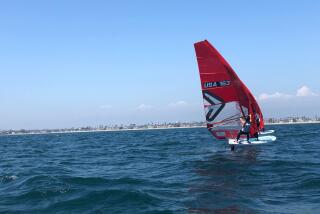Sailboat Show Numbers Reflect a Power Move
- Share via
ANNAPOLIS, Md. — Following a national trend, the U.S. Sailboat Show opened here Friday with one-third fewer boats in the water than just 2 years ago.
“We’ll have about 225 sailboats in the water, which is the same as last year,” said show organizer Jeff Holland. But that’s down 125 boats from 1986, reflecting the overall condition of the marine market, where “sailboats are flat and powerboats are booming,” Holland said.
The show, which opened its five-day run in brilliant sunshine at City Dock, nonetheless remains one of the premier sailboat expositions in the world. And if Holland was smiling, it was in part because he also organizes the following weekend’s U.S. Powerboat show, the biggest ever this year with twice as many boats in the water as the sailboat show.
The phenomenon of powerboats overtaking sailboats has long been common on the water hereabouts, but it only recently started occurring in showrooms.
Holland suspects the shift comes partly because the public believes there’s something mystical and complex about operating a sailboat, while anyone can jump in a powerboat and turn the key.
The result, he said, is that people with a maritime bent and money increasingly are throwing it into boats with big motors.
It’s not true that you need to be a Dennis Conner to operate a sailboat, Holland said, “but no one in the industry is doing enough to change the image.”
All around the show, as folks in Topsiders and cotton sweaters roamed, inspecting yachts they probably never can afford, observers of the industry puzzled over what the sailboat trade has to do to get back on a roll.
“We could use a good hurricane,” said Charlie Scott, the Chesapeake Bay’s top racing skipper and dealer of “J” boats from 22 to 41 feet long.
Scott said older fiberglass sailboats are cramming the used-boat market, leaving new-boat salesmen little room to compete. Fiberglass has been in widespread use in boats for years. The problem, Scott said, is it doesn’t wear out fast enough.
Hakan Carlsson of Volvo-Penta, the Swedish diesel enginemaker, said U.S. manufacturers spend too much time and money pushing big boats that most consumers will never be able to afford.
He said Volvo is sponsoring small boat racing regattas in Newport and San Francisco in hopes of getting more people involved in sailing at an affordable level, with the hope that once they learn to love the sport they’ll buy bigger boats, hopefully with his engines to get them home when the wind dies.
Former Sail Magazine editor Keith Taylor said the problem runs deep. “The American love affair with big motors is legendary,”
More to Read
Sign up for The Wild
We’ll help you find the best places to hike, bike and run, as well as the perfect silent spots for meditation and yoga.
You may occasionally receive promotional content from the Los Angeles Times.






